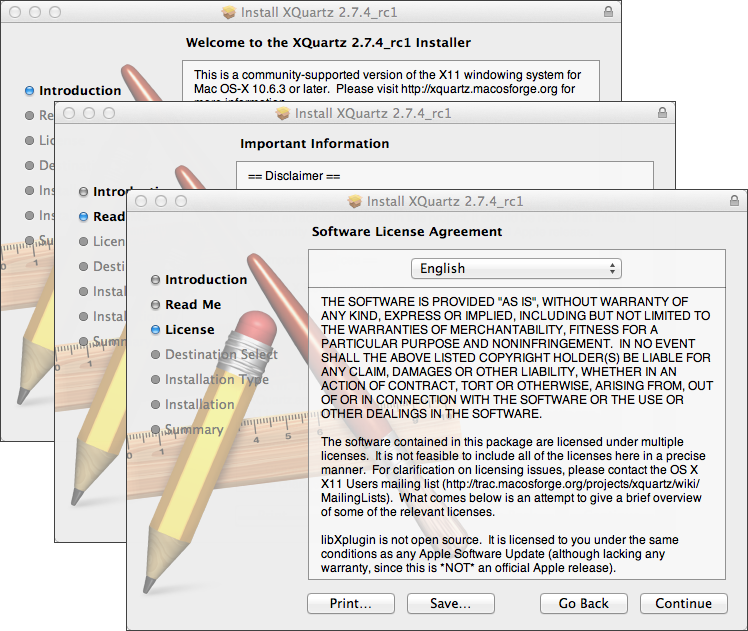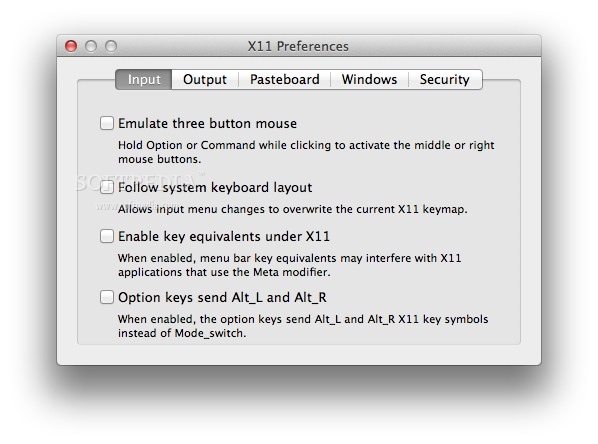On MacOS X, XQuartz enables you to use the X11 window system.
Step 2: Install XQuartz with the help of Homebrew. XQuartz is another open source program that you need to install, as in order for Wine to install properly Xquartz is needed. Homebrew allows you to very easily install this, all you have to do is enter the following command into the terminal: brew cask install xquartz In the above command. Click the box labelled 'Mac OS X 10.7 Installer (xQuartz)' to download the.dmg file, which contains this installer. A new window showing the installer downloading will appear in your browser window. Once it's fully downloaded, go to the folder your browser is set for files to be downloaded into — usually it's the Downloads folder (System. XQuartz for Mac 2020 full offline installer setup for Mac XQuartz for Mac is an open-source effort to develop a version of the X.org X Window System that runs on Mac OS X. Together with supporting libraries and applications, it forms the X11.app that Apple shipped with OS X versions 10.5 through 10.7. Apr 28, 2021 Download the latest version of XQuartz for Mac for free. Read 25 user reviews and compare with similar apps on MacUpdate.

1. Install XQuartz application
Here we provide two ways to install XQuartz application. You could either install from official website or install with Homebrew. In general, we recommend you to use Homebrew to install and manage packages on MacOS X.
- Download and install directly from XQuartz.
- Install with Homebrew. There are two steps: 1. Homebrew Cask is an extension of Homebrew. It installs GUI applications under the framework of Homebrew. Install Homebrew Cask with command
brew tap caskroom/cask. 2. Install XQuartz with commandbrew cask install xquartz.
2. Validate X11 installation on your Mac
Open XQuartz application from the launchpad on your Mac to see if it is installed correctly. It will open an xterm window. If that does not work immediately, try restarting your computer.
3. Validate X11 connection to remote server
Next, try running an X11 application on one of the CS50 Unix servers. Log into a CS50 Unix server and launch an X11 application, such as xclock or xemacs. For a little fun, try xeyes.
The -X option to ssh sets up X11 forwarding for ssh connections. That is, it sets up a secure tunnel between the program (like xclock) running on the server and the XQuartz application on your Mac; the program can create windows, buttons, menus, etc.; all the information flows through the ssh tunnel to XQuartz, which renders the windows on your Mac. It works with all CS50 Unix servers. xpdf will open a pdf viewer in X windows system on your local computer. Here’s an xpdf window.
Note
A warning may show up saying $Home/.Xauthority does not exist if it is your first time to use X11. The Xauthority file will be configured automatically at the first run. From then on, the warning should not appear.
Reference
Your first GTK+ application
If you need a GUI (graphical user interface), we recommend the gtk+ library, which is a popular UI toolkit for the X11 window system. There are two versions of gtk+ libraries: gtk+-2(version 2) and gtk+-3(version 3). gtk+-2 is still alive but we recommend the latest version, gtk+-3. Both versions are ready to use on our CS50 Unix servers, so you need to specify the version to work with at compile time.
The gtk-example.c example program, below, uses gtk+-3. It opens a window with a simple button, as shown below the code. Feel free to use!
Compiling with gtk+
Use the following command to compile gtk-example.c:
pkg-config --cflags gtk+-3.0 will produce a list of header paths you might use in your application and pkg-config --libs gtk+-3.0 will produce a list of library paths. (Notice the use of back-ticks for bash command substitution.) A more detailed explanation can be found in references below, which include a well-written tutorial.
Reference
Wine has been a long-standing open source software. It is highly popular because it aims to allow the computer programs that have been developed for Microsoft Windows to run on Mac and other Unix-based systems. Mac users have especially been using it to run Windows applications on Mac, so if you are one such user, you have come to the right place. In this article, we will be talking all about Wine and how you can download & install it on your Mac, as well as run it and use it.
Contents
- 1 Wine for Mac: Everything You Need to Know
- 1.1 Installing Wine on your Mac
Wine for Mac: Everything You Need to Know
Wine is a pretty old application, first launched in 1993. It is completely free as well as legal. Even though Boot Camp is available, which allows you to install Windows on a Mac, you are required to boot up every time you want to run Windows. Wine helps you cut to the chase and run a Windows program directly.
When a program runs, it asks for resources like disk and memory space from the OS, which Wine makes sure get answered.
Wine is way better than Boot Camp or virtualization like Parallel Space, which makes it so ideal. However, there might be a slight chance that your program may not work with Wine. You will have to try to run it for that.
Let’s get Started!
Installing Wine on your Mac


To get Wine on Mac, we will first look into the system requirements, and then we will outline the steps in detail.
System Requirements
The following are the requirements of your system to install Wine for Mac:
- macOS 10.10 (Yosemite) or above
- Access to an Admin account, with password
- An Internet Connection
Now that we have gone through these, let us take a look at the various steps you will be going through to install Wine for Mac.
Step 1: Installing Homebrew
Homebrew is a package manager. It facilitates the installation of open source programs, including Wine, a pretty easy task. Wine is big in size, which is why it’s better to install it.
To install Homebrew:
- Run the Terminal
- In the command line, type:
ruby -e “$(curl -fsSL https://raw.githubusercontent.com/Homebrew/install/master/install)”
- The Terminal will ask your permission, as well as ask for the password. Enter them and continue.
- No character will be displayed while you type your password, but don’t worry the Terminal is taking the password as input.
- Homebrew should take no more than a few minutes to install.
- Once that is done, all you have to do type the following into the terminal and press enter:
Download Xquartz Mac Os
brew doctor
- If everything goes correctly, you should see the message ‘Your system is ready to brew’. We will proceed to the next step.
If you do get asked by the terminal to agree with the Xcode License, you can do that easily by typing the following into the terminal:
sudo xcodebuild License

Then, just read the agreement, agree to it and proceed.
Step 2: Install XQuartz with the help of Homebrew
XQuartz is another open source program that you need to install, as in order for Wine to install properly Xquartz is needed. Homebrew allows you to very easily install this, all you have to do is enter the following command into the terminal:
brew cask install xquartz
In the above command:
- brew refers to Homebrew
- cask is a reference to Homebrew Cask, which installs GUI (Graphical User Interface) Application on your Mac
- install xquartz is self-explanatory, meaning that you are installing the xquartz program on your Mac
Once the installation is complete, Terminal will pause and then wait for your next command, i.e. the next step.
Step 3: Wine Installation
Now that we have everything ready, all we have to do is install Wine on Mac. Homebrew will install it for us, just type the following in the terminal:
brew install wine
Now, Wine will be installed on your MacOS by Homebrew. That’s it!
Installing and Running Windows Programs on Mac using Wine
Now that Wine has been installed correctly, we will see how we can run Windows Programs on our Mac using Wine.
- Get the installer file .exe
- Keep in mind its location
- Using cd, navigate to the directory where the installer file is being stored
- Now, run the following command in the terminal:
wine $INSTALLNAME.exe
where ‘$INSTALLNAME’ will be replaced by the installer file name. For example, if the installer file name is ‘fastsetup.exe’, type
wine fastsetup.exe
You will now see the installer window, where the instructions will be self-explanatory for you to install the Windows Program.
Now, let us see how to run our Windows Program on MacOS using Wine.
- Enter the following command in the terminal- we will be navigating to the Program Files directory:
- cd ~/.wine/drive_c/Program Files/
- Now, navigate to your installed program’s directory among the list (which you can see using the ls command). You can navigate using the cd command. Check out any command list website to learn how to use these commands.
- You will find the .exe file of your installed program. To run it, type the following into command prompt;
wine $program.exe
where ‘$program’ will be replaced by the name of your program, just like before.
- Now, you will see a window pop up and your Windows Program will start running perfectly! That is how you can install and run Windows Programs using Wine.
Final Take
We hope that by reading this article you were able to install Wine on your Macbook. If you have any further queries regarding the steps mentioned in this article, you can drop us a comment below and we’ll do our best to get back to you with a relevant answer.